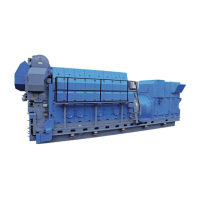Often the heater surface is partly clogged by deposits. These factors all lead
to reduced separation temperature and hence the efficiency of the separator
unit. In order to ensure that the centrifugal forces separate the heavy con-
taminants in the relatively limited time that they are present in the separator
bowl, the separator unit must always be operated with an inlet temperature
of 95-98°C for lubricating oil.
A control circuit including a temperature transmitter and a PI-type controller
with accuracy of ±2°C must be installed. If steam-heated, a correctly sized
steam valve should be fitted with the right KvS value. The steam trap must
be a mechanical float type. The most common heaters on board are steam
heaters. This is due to the fact that steam in most cases is available at low
cost.
Most ships are equipped with an exhaust boiler utilizing the exhaust gases to
generate steam.
A large proportion of smaller tonnage does, however, use electric heaters.
It is essential to keep the incoming oil temperature to the separator unit
steady with only a small variation in temperature allowed (maximum ±2°C).
The position of the interface between oil and water in the separator bowl is a
result of the density and the viscosity of the oil, which in turn depends on the
temperature.
Flow rate
It is known that separation efficiency is a function of the separator unit’s flow
rate. The higher the flow rate, the more particles are left in the oil and there-
fore the lower the separation efficiency. As the flow rate is reduced, the effi-
ciency with which particles are removed increases and cleaning efficiency
thus improves. It is, however, essential to know at what capacity adequate
separation efficiency is reached in the specific case.
In principle, there are three ways to control the flow:
▪ Adjustment of the built-in safety valve on the pump.
This method is NOT recommended since the built-on valve is nothing but
a safety valve.
The opening pressure is often too high and its characteristic far from lin-
ear.
In addition, circulation in the pump may result in oil emulsions and cavita-
tion in the pump.
▪ A flow regulating valve arrangement on the pressure side of the pump,
which bypasses the separator unit and re-circulates part of the untreated
lubricating oil back to the treated oil return line, from the separator unit
and NOT directly back to the suction side of the pump.
The desired flow rate is set manually by means of the flow regulating
valve. Further, the requirement for backpressure in the clean oil outlet
MUST also be fulfilled, helping to maintain the correct interface position.
▪ Speed control of the pump motor with a frequency converter or a 2-
speed motor.
This is a relatively cheap solution today and is a good alternative for flow
control.
2016-02-26 - en
Description
Treatment and maintenance of lubricating oil
1643494-3.11
MAN Diesel & Turbo
B 12 15 0
L28/32S; L27/38S; L23/30S; L21/31S; L16/24S; L23/30DF; V28/32S-DF;
L28/32DF; V28/32H; V28/32S; L16/24; L21/31; L23/30H; L27/38;
L28/32H EN
9 (11)

